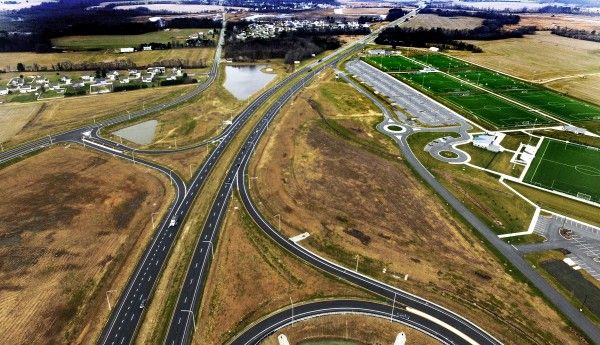Frederica, Little Heaven ripe for economic development
6 JANUARY, 2019 | DELAWARE STATE NEWS

FREDERICA, DE – The governor’s certification of Kent County’s 2018 Comprehensive Plan came with a caveat — a master plan must be drafted and adopted for a large portion of Little Heaven and South Frederica in the orbits of both the newly constructed Del. 1 interchanges in the area. State planners suspect that the interchanges raise the areas profile in terms of accessibility and as such, the groundwork should be laid for future development.
That master planning process began in December and stakeholders say a foundational meeting suggested that both these locations may be well-suited to become large employment centers in the next five to 10 years.
Chairing the working group to initiate the master plan, fourth district Kent County Levy Court commissioner Eric Buckson says the combination of the new interchanges, growing popularity of the DE Turf Sports Complex and a proposed Delaware Transit Corporation 265-vehicle park-and-ride facility at the complex makes this area ripe for development.
“In south Frederica, we’re seeing the possibility for a sort of commercial district that could support some of the activities going on at DE Turf recreationally — there’s a real opportunity for retail, commercial and entertainment-type businesses there,” he said. “For Little Heaven, there’s a possibility for something like a large health campus or something related to medical services — we’re definitely going to continue to need those types of things as the county ages. Both spots are well-positioned for great employment and service centers.”
Mr. Buckson is quick to point out that the master planning process is only an effort to pull together data and make projections about the targeted area. How it develops remains up to the local landowners.
“With the state’s investment in the new overpasses comes the reality that people will want to come in and develop the land — we’re not trying to stop or control that,” said Mr. Buckson. “With the plan though, we can manage and create a more defined expectation of what could go in these areas versus simply leaving it as is and dealing with new developments piecemeal. The land owners maintain control. If their desire is to keep it farmland, residential or otherwise, it’ll remain that way. But, in the event that they change their minds after the master plan has been created, there is a rough blueprint for how economic development opportunities might expand.”
Mr. Buckson, working alongside the master planning vice-chair Gregg Moore (chairman of the Kent Economic Partnership), felt that the first meeting was constructive and accomplished the mission of bringing the relevant state agencies, residents and local representation to the table to discuss the area’s future. He says the next step is to being drafting the plan and meeting one-on-one with more property owners in the affected areas.
Linda Parkowski, the executive director of the Kent Economic Partnership, says similar master plans in the state have quickly led to economic development.
“In Milford, they planned the southern part of their city and the hospital went there — with master planning complete, they had a much better idea what they were looking at,” she said. “We’ve also seen Amazon go to Middletown over Smyrna because Middletown had their master planning complete. The process is extremely important for economic development.”
Invested in the process herself, Ms. Parkowski says master plans help collate important infrastructure, utility access, transportation, land use, environmental and demographic data that weigh heavily in large employer’s decisions when considering locations.
Responsible for collecting much of this information, County Administrator Michael Petit de Mange said the next few months will be consumed with working with property owners and state agencies to iron out specifics.
“The areas themselves involve a lot of property owners we need to work alongside on the plan,” he said. “Other early tasks will include meeting with water, electric and gas utility providers and working with DelDOT and DNREC to understand the limitations and opportunities of the area. However, there aren’t a whole lot of wetlands, water impacts or woodland impacts. There are some excellent groundwater recharge areas around Little Heaven that we’ll need to work with to some degree.”
Agreeing with Mr. Buckson, Mr. Petit de Mange feels the first meeting with stakeholders was constructive and provided an early look at the possible destiny of the area.
“The area around Little Heaven seems suited to a large professional officer or campus-type of employment center,” he said. “Down around south Frederica, smaller more mixed-use commercial and business zoning that would support both the sports complex and the town of Frederica seemed more appropriate. These were some of the main ideas discussed at the meeting.”
Image courtesy of Gary Emeigh
This article was originally posted on the Delaware State News at: https://delawarestatenews.net/news/frederica-little-heaven-may-be-ripe-for-economic-development/
Newsletter Sign Up
Stay Up To Date With Delaware
